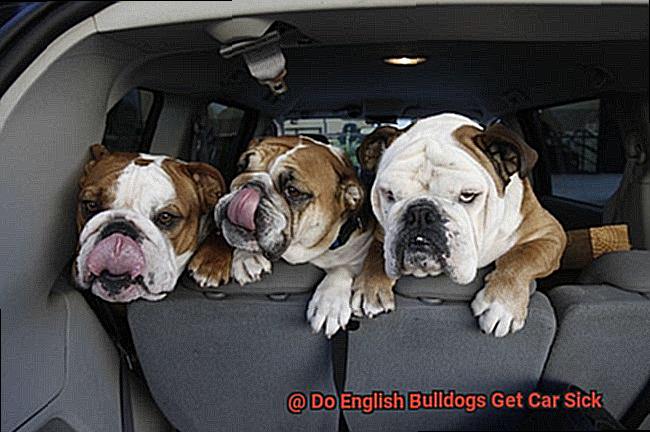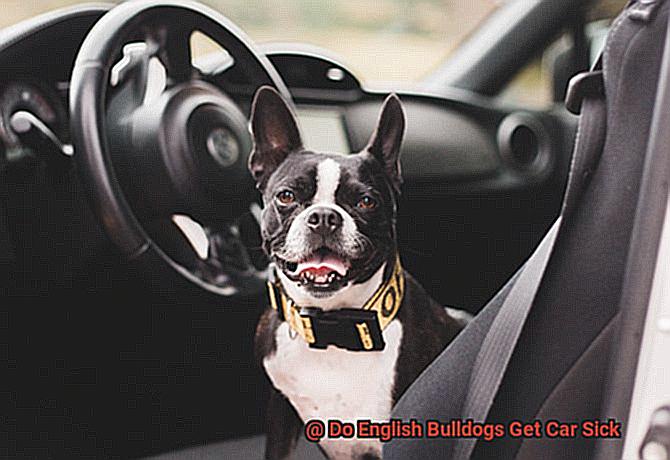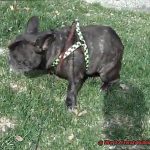Do English Bulldogs Get Car Sick?
Do English Bulldogs get car sick?
It’s a common question among pet owners who want to take their four-legged friends on a ride. After all, no one wants to see their beloved pup suffer from motion sickness.
But the answer isn’t as straightforward as you would expect. Motion sickness is triggered by the brain exchanging information between the eyes and inner ear, which can cause nausea and vomiting.
Dogs have less control over their heads than humans, so they’re more likely to experience motion sickness if they’re bouncing around in the backseat with no restraint. So are English Bulldogs more prone to car sickness than other breeds?
Unfortunately, there isn’t much research out there on this topic. But what we do know is that brachycephalic (or short-nosed) breeds such as Bulldogs are more susceptible due to their anatomy.

Providing plenty of fresh air, limiting food intake prior to travel and using specially made crates or seatbelt harnesses can help ensure a safe and enjoyable ride for both you and your furry companion.
What is Motion Sickness?
Contents
- 1 What is Motion Sickness?
- 2 Symptoms of Motion Sickness in Bulldogs
- 3 Preventing Motion Sickness in Bulldogs
- 4 Genetics and Brachycephalic Skull Shape
- 5 Avoid Feeding Before a Car Ride
- 6 Provide Adequate Ventilation
- 7 Consult with a Veterinarian for Medication
- 8 Make Your Bulldog Feel Comfortable During Car Rides
- 9 Conclusion
Motion sickness is a common condition that affects both humans and animals, including our beloved English Bulldogs.
It occurs when the eyes see something different than what the body senses, such as when reading while in a moving vehicle. The inner ears detect motion and send signals to the brain, causing confusion when the eyes do not confirm this movement.
This can lead to symptoms such as nausea, vomiting, dizziness, and general discomfort. English Bulldogs are particularly prone to motion sickness due to their sensitivity to changes in motion and their tendency to get quickly excited or anxious.
Additionally, their stocky build and big head can further exacerbate their imbalance and discomfort during movement. Symptoms of motion sickness in English Bulldogs may include excessive drooling, lethargy or restlessness, whining or crying, and vomiting.
If you suspect your English Bulldog is suffering from motion sickness, it is important to make them feel as safe as possible during car rides. Start by taking short car rides, gradually increasing the duration and distance of the ride as your Bulldog becomes more familiar with it.
To give you a sense of security, you can also place familiar items such as a favorite toy or blanket in the car. In addition, avoiding feeding your Bulldog prior to a ride and providing adequate ventilation can help reduce any motion-related symptoms that may be present.
Symptoms of Motion Sickness in Bulldogs
Motion sickness is a common issue for English Bulldogs, and can make car rides a traumatic experience for both pup and owner.
Symptoms to look out for include drooling, panting, vomiting and even diarrhea. While not all Bulldogs suffer from motion sickness, age, temperament and overall health can affect their susceptibility.
Thankfully, there are several ways to make car rides more comfortable for your Bulldog. Try limiting the length of the ride initially, introducing familiar items such as toys or blankets to reduce anxiety, and ensuring adequate ventilation so that fresh air circulates throughout the vehicle.
If you’re still worried about your Bulldog’s motion sickness signs, it’s best to consult with a veterinarian who can prescribe medications or other therapies to help alleviate their discomfort.
Preventing Motion Sickness in Bulldogs
If so, you may already be aware that car rides can cause them to suffer from motion sickness.
This can lead to drooling, panting, vomiting, and diarrhea – all of which can make your pup uncomfortable and miserable. Thankfully, there are several ways to prevent motion sickness in Bulldogs and make car rides as enjoyable as possible.
To begin with, it’s important to gradually acclimate your Bulldog to car rides. Start by taking short trips around the block and gradually increasing the ride’s length over time.
This helps your pup get used to the motion of the car and reduces the chances of motion sickness. It’s also essential to ensure your Bulldog’s comfort while on the road.
Make sure they have plenty of fresh air, cool water, and a comfortable spot to sit or lie down. You may also consider providing them with a favorite toy or blanket for added security and relaxation.
In addition, some pet owners find success with using medication to prevent motion sickness in Bulldogs. Talk to your veterinarian about safe and effective medications for Bulldogs as some may be sensitive to certain drugs.
It is important to note that medication should only be used as a last resort – always consult a professional before doing so. Finally, natural remedies like ginger or peppermint can also help reduce motion sickness in dogs.
Genetics and Brachycephalic Skull Shape
English Bulldogs are known for their brachycephalic skull shape, which can make them particularly susceptible to car sickness.
The short, wide skull affects their respiratory system and balance mechanism, making them prone to nausea and anxiety when in motion. If you plan to take your English Bulldog on a long car journey, it’s important to take preventative measures.
Feeding your dog several hours prior to the trip and using a harness during the drive will help reduce motion sickness symptoms. Additionally, frequent potty and walking stops can help keep your pet comfortable during the ride.
However, it’s always best to consult with your veterinarian before giving any medications.
Avoid Feeding Before a Car Ride
Taking your English Bulldog on a car ride can be a bumpy experience, as Bulldogs are prone to motion sickness due to their irregular skull shape.
To ensure that your pup stays safe and comfortable on your next road trip, it’s essential to avoid feeding them before the journey. Giving your Bulldog a full meal before the ride can cause them to vomit or feel nauseous during the journey, so it’s best to wait at least two hours before feeding them.
If you have a long trip ahead, provide small meals at intervals rather than one large meal. It’s also important to give your Bulldog plenty of time to relieve themselves before getting in the car.
A full bladder can bring additional stress and anxiety during the ride, which can lead to motion sickness. As an alternative to feeding them before the car ride, you can offer them a light snack such as kibble or plain cooked chicken or turkey.
This will help keep their stomach calm without overburdening it with food.
Provide Adequate Ventilation
It’s essential to provide adequate ventilation for English Bulldogs during car rides, as it can make all the difference in preventing motion sickness.
To keep your pup comfortable and safe, open the windows or use air conditioning to circulate fresh air. Additionally, avoid smoking or using strong perfumes or air fresheners in the car, as these scents can exacerbate nausea in dogs.
When driving with an English Bulldog who is prone to car sickness, aim for smooth roads with no sharp turns or bumps. This will help reduce jostling and bouncing which can also contribute to nausea.
You should also feed your pup a light meal several hours before the ride; fasting may also be an option if your dog is prone to vomiting or nausea. If your English Bulldog does experience car sickness during a ride, be sure to pull over and provide them with a chance to rest and recover.
Give them some water, but don’t feed them until they are calm and no longer showing symptoms. In some cases, medication may be prescribed by a veterinarian to alleviate the symptoms of motion sickness; make sure you consult with one before administering any medications.
Consult with a Veterinarian for Medication
Traveling with your beloved English bulldog can be an enjoyable experience, but it can also be a stressful one if car sickness is a factor.
Fortunately, there are some steps you can take to minimize the risk of motion sickness in your pup. The first and most important step is to consult with a veterinarian.
They will be able to properly diagnose the issue and provide medications or other remedies that can help alleviate the symptoms. Common medications used to treat car sickness in dogs include Cerenia, Maropitant, and Acepromazine.
In addition to medication, there are some other treatments that your vet may suggest. For example, they may recommend withholding food for a period of time before traveling, as this can reduce the likelihood of vomiting.
They may also suggest using a Thundershirt or similar calming wrap to help reduce anxiety and motion sickness. Lastly, you’ll want to make sure your pup is as comfortable as possible during car rides by introducing them slowly and gradually increasing the duration and distance of the ride as they get used to it.
You may also want to place some familiar items such as their favorite toy or blanket in the car for added comfort.
Make Your Bulldog Feel Comfortable During Car Rides
If your English Bulldog suffers from motion sickness, car rides can be a stressful experience for both of you.
But, with a few simple steps, you can make the journey more comfortable and reduce the chances of them getting sick. Start by ensuring your bulldog is well-rested and not overly full before the ride.
A few hours before, give them a light meal, but avoid feeding them right before the trip as this can increase their chances of nausea. Keep the vehicle well-ventilated and try to avoid sudden stops or turns that could jostle your bulldog.
To provide extra safety and reduce their anxiety, consider using a dog seat belt or travel crate during the ride. Offer plenty of fresh water and take regular breaks to allow your bulldog to stretch their legs and relieve themselves.
Additionally, play soothing music or use calming scents like lavender to help relax your furry friend during the car ride. If your bulldog does experience motion sickness during car rides, there are several over-the-counter medications that may help alleviate their symptoms.
oCzSeeqfve8″ >
Conclusion
English Bulldogs may be more prone to motion sickness than other breeds, but with the right precautions, car rides can still be enjoyable for your pup.
To minimize the chance of car sickness, feed your Bulldog a light meal several hours before the ride and give them plenty of fresh air. You can also use a harness or travel crate to make sure they feel safe and secure.
If you’re still concerned about motion sickness symptoms, talk to a doctor for advice on how to cope with them while traveling with your pup.




